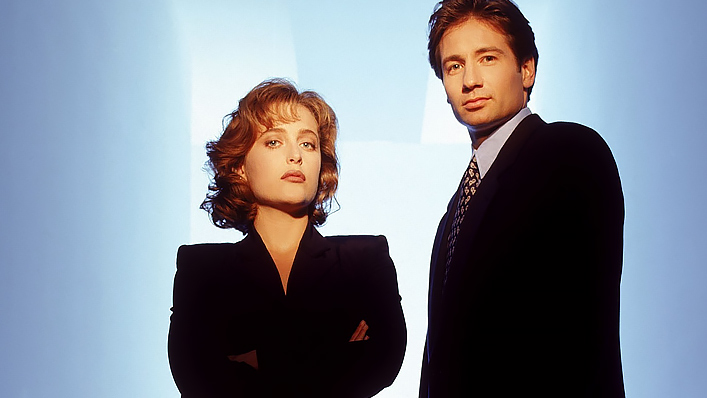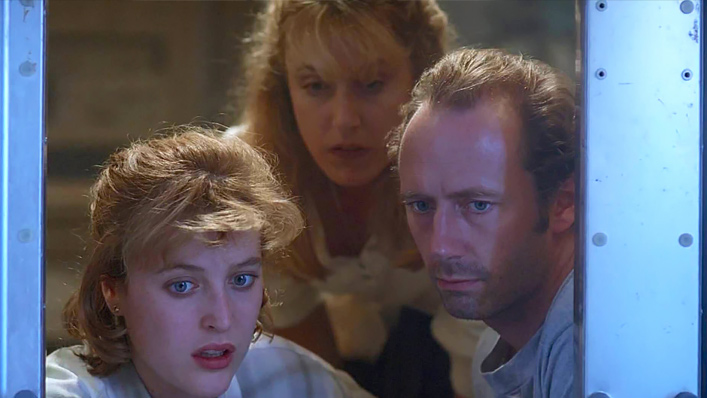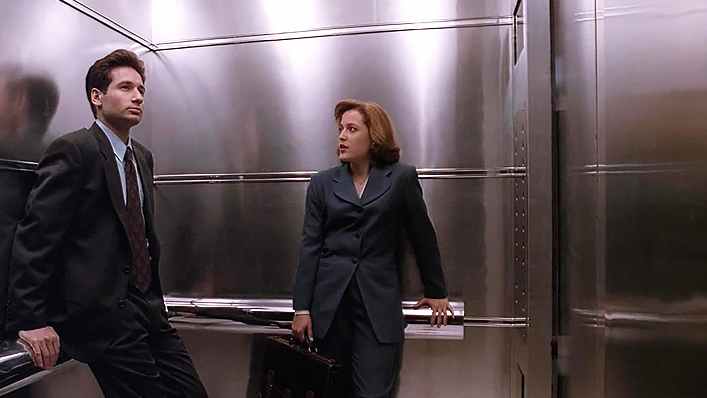The first season of The X-Files is still perfect science fiction television

This month Prime Video added The X-Files seasons 1-11 to its catalogue. Twenty-seven years on, critic Sarah Ward explains why the first season is still damn fine television.
When The X-Files arrived in 1993, it took exactly three episodes to make a mark. The sci-fi show introduced FBI Special Agent Fox Mulder (David Duchovny) and his new partner Dana Scully (Gillian Anderson), the program’s penchant for the paranormal, and its case-of-the-week format. It followed up with more possible alien activity and a suspected government cover-up, both series staples. Then came episode three, Squeeze.
See also
* Top 5 science fiction series to stream
* Best new movies & TV shows on Prime Video
* All new streaming movies & series
Every X-Files viewer remembers Squeeze. Perhaps not by name—you may think it’s called Tooms, the title of its follow-up episode in the same season—but the details are unforgettable. Set in Baltimore, it starts with a murder and the removal of the victim’s liver, all in an office that’s locked from the inside with no signs of forced entry. As viewers witness, the culprit, Eugene Victor Tooms (Doug Hutchison), can elongate his body to slither through extremely tight spaces. If that’s not unnerving enough (and a clever take on the “it’s coming from inside the house” trope), Tooms has used his talents in multiple killings dating back to 1903.
Squeeze epitomises the show at its perturbing best
Squeeze is ominous, inventive and enthralling. Its opening scene is edge-of-your-seat viewing—and the entire concept, from Tooms unique physical ability and liver-fuelled flouting of mortality to his bile-slathered hidey-hole, intrigues and unsettles. Although inspired by Jack the Ripper and 1973 Kolchak film The Night Strangler, writers Glen Morgan and James Wong twist the sinister tale in clever, creepy and compelling ways, while, visually, the episode emphasises Tooms’ contorting capacity through canny camera angles.
It’s no wonder that series creator Chris Carter positioned it as the show’s first ‘monster-of-the-week’ instalment, nor that it became the first X-Files episode with a sequel. Squeeze epitomises the show at its mesmerising and perturbing best, and sets the scene for a memorable first season.
On paper, The X-Files’ premise is simple: a law enforcement procedural about unexplained phenomena. Its enjoyable character dynamic is straightforward, too, with Mulder (nickname: Spooky) obsessed with the strange, supernatural, otherworldly and extra-terrestrial, and skeptical, rational, medically trained Scully assigned to keep him in check. But both Squeeze and the show’s first season establish that, as much as a template is evident, The X-Files doesn’t fit neatly into any box. The program itself apes both its leads—aware of the hoops it needs to jump through, but eagerly veering in its own direction.
It doesn’t trot out the same old stories
Now on Prime Video, the first season demonstrates this again and again. Deja vu ripples through many of its ‘monster-of-the-week’ cases, and not just because they usually link back to a decades-old crime that only Mulder knows about. But when The X-Files dallies with Bigfoot, exsanguination, lycanthropy and ghosts, it doesn’t just trot out the same old stories. Take Eve, which begins with two dead men sporting puncture marks in their neck. The show knows what audiences are instantly thinking, but draws upon human cloning and The Shining-level twin creepiness instead.

When The X-Files borrows from clear-cut pop culture sources in its first season, too, the same applies. Ghost in the Machine owes a debt to 2001: A Space Odyssey and The Terminator (and arrived in the same year 1993 film Ghost in the Machine), yet grounding its artificial intelligence-fuelled tale in the workings of the IT industry provides a savvy, even prescient edge. In Ice, there’s no missing the resemblance to The Thing from Another World and The Thing. Letting a deadly organism tear through the crew of an icy research station—albeit in Alaska, not Antarctica—will do that. Again, though, The X-Files makes the narrative its own, including in subtly linking to the show’s alien mythology.
Even laced with familiar elements, these episodes are tightly and stylishly made, suspenseful and full of surprises. Like all other episodic sci-fi series—The Twilight Zone, most famously—of course The X-Files is going to touch upon well-known tales and tropes. It’s how the show twists these familiar elements to create something new, with Mulder and Scully at the centre, that adds extra thrills.

The X-Files is about being open to the inexplicable
And, as Ice illustrates, how these stories tie into series’ overarching, big-thinking, Mulder-led fascination with the unexplainable is also crucial. He wants to believe, the poster in his office advises. He’s certain the truth is out there, as the show’s tagline announces at the beginning of most episodes.
Being open to the inexplicable—tracking it down, exposing it, proving it—is the show’s conceit; however, recognising the strange and spooky within well-worn confines is just as essential to Mulder’s quest to confirm the existence of extra-terrestrial life, the US government’s knowledge of it and the corresponding high-level cover-up. In its first season, this is the crux of The X-Files, and the series always conveys it astutely and entertainingly.
The X-Files’ first season also provides more than a few instances of Scully sighing in disbelief at Mulder, too, but gradually becoming willing to trust his latest theories. This interplay is as iconic and revealing as any other part of the show—and is worth revisiting this sci-fi TV great to enjoy.
Watch The X-Files on Prime Video

















